Developing an Evidence-Based Tool for Dementia Care Education
VerifiedAdded on 2023/04/25
|14
|1630
|395
Project
AI Summary
This project outlines the development of an evidence-based educational tool designed to address the knowledge and understanding gaps among dementia care staff and family carers of patients with dementia. The tool aims to enhance the knowledge of dementia care staff in handling patients with challenging behaviors and to educate family members in managing the resistance often exhibited by dementia patients. It acknowledges the increasing prevalence and impact of dementia, highlighting the need for improved training in areas such as stress management, patient self-care, personal hygiene, and continuous surveillance. The tool emphasizes personal hygiene, self-care assistance, compassion, active listening, and therapeutic engagement, while also addressing medication management and challenging behaviors through cognitive mindfulness therapies. Ultimately, the project seeks to improve the quality of dementia care, patient satisfaction, and caregiver well-being by disseminating knowledge and transferring skills within the target group. The document is contributed by a student and available on Desklib, a platform offering study tools and resources for students.
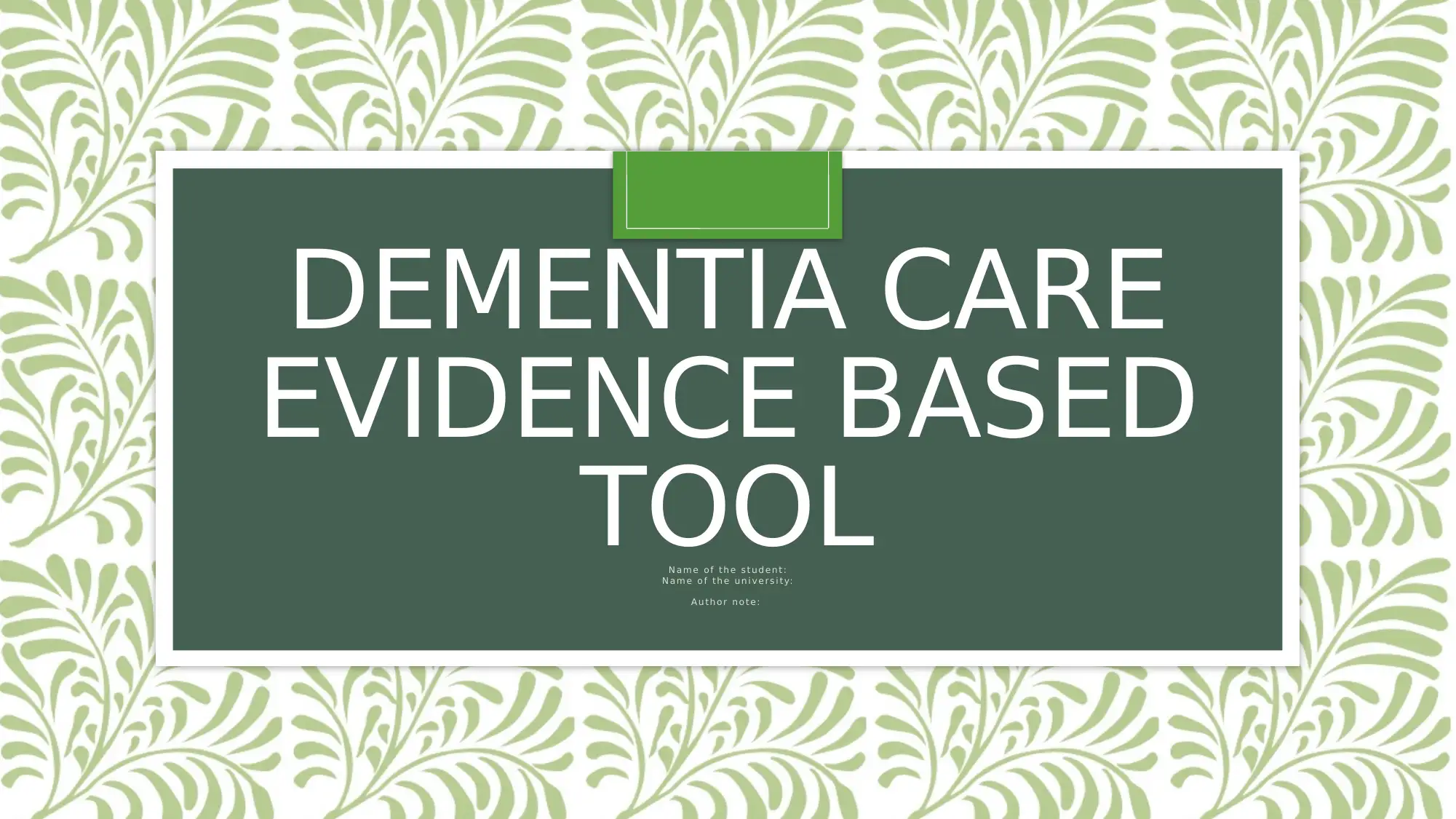
DEMENTIA CARE
EVIDENCE BASED
TOOLN a m e o f t h e s t u d e n t :
N a m e o f t h e u n i v e r s i t y:
A u t h o r n o t e :
EVIDENCE BASED
TOOLN a m e o f t h e s t u d e n t :
N a m e o f t h e u n i v e r s i t y:
A u t h o r n o t e :
Paraphrase This Document
Need a fresh take? Get an instant paraphrase of this document with our AI Paraphraser

Introduction
• The educational tool has been developed for
the target group of dementia care staff and
their family members.
• The chosen issue is the gap in education and
knowledge in the target patient groups and
their family members regarding the disease
and how to address the disease (Griffiths et
al. 2015).
• The tool will take into consideration changing
the level of knowledge and understanding on
Dementia care and addressing challenging or
complex behavior
• The educational tool has been developed for
the target group of dementia care staff and
their family members.
• The chosen issue is the gap in education and
knowledge in the target patient groups and
their family members regarding the disease
and how to address the disease (Griffiths et
al. 2015).
• The tool will take into consideration changing
the level of knowledge and understanding on
Dementia care and addressing challenging or
complex behavior
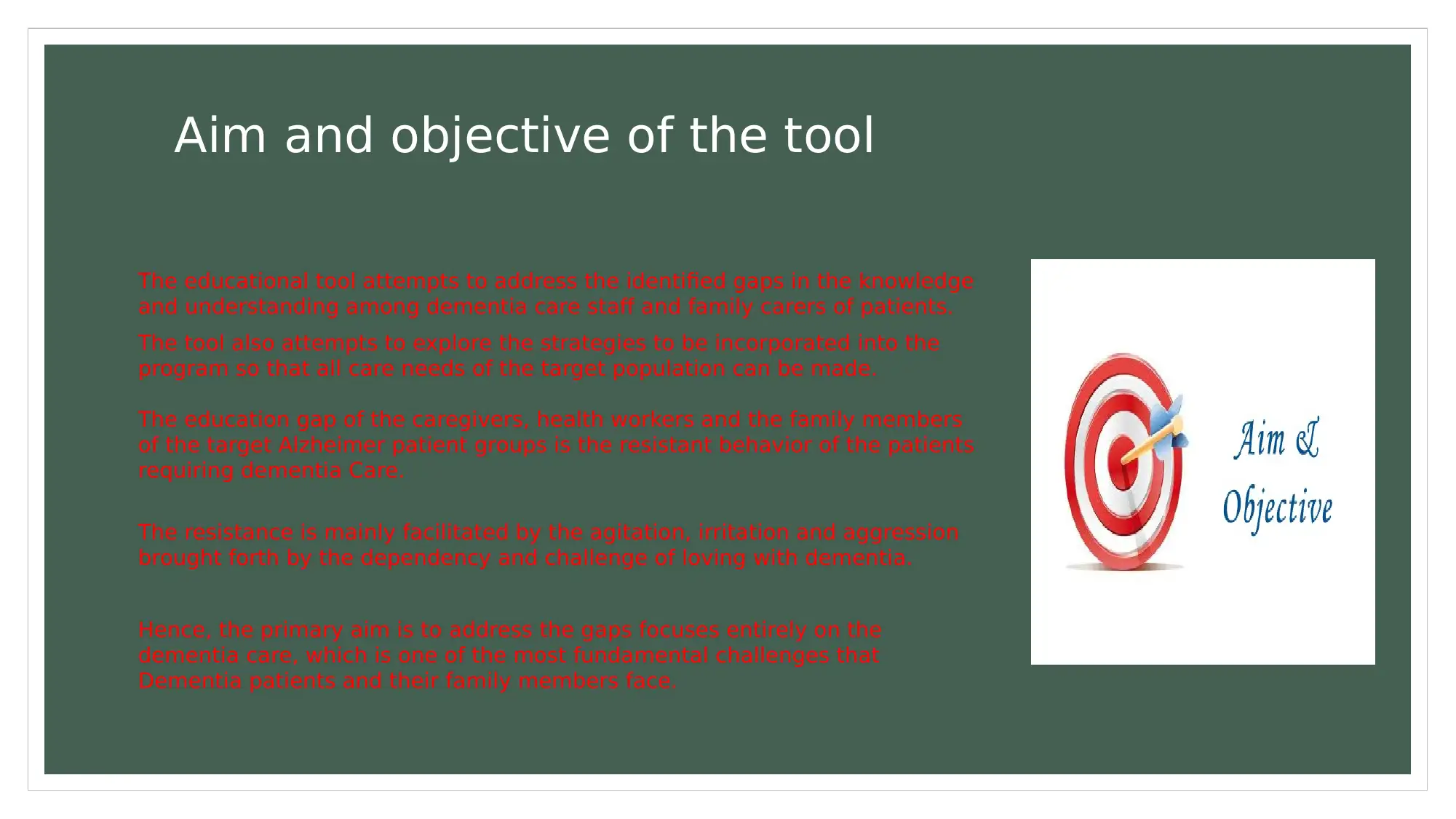
The educational tool attempts to address the identified gaps in the knowledge
and understanding among dementia care staff and family carers of patients.
The tool also attempts to explore the strategies to be incorporated into the
program so that all care needs of the target population can be made.
The education gap of the caregivers, health workers and the family members
of the target Alzheimer patient groups is the resistant behavior of the patients
requiring dementia Care.
The resistance is mainly facilitated by the agitation, irritation and aggression
brought forth by the dependency and challenge of loving with dementia.
Hence, the primary aim is to address the gaps focuses entirely on the
dementia care, which is one of the most fundamental challenges that
Dementia patients and their family members face.
Aim and objective of the tool
and understanding among dementia care staff and family carers of patients.
The tool also attempts to explore the strategies to be incorporated into the
program so that all care needs of the target population can be made.
The education gap of the caregivers, health workers and the family members
of the target Alzheimer patient groups is the resistant behavior of the patients
requiring dementia Care.
The resistance is mainly facilitated by the agitation, irritation and aggression
brought forth by the dependency and challenge of loving with dementia.
Hence, the primary aim is to address the gaps focuses entirely on the
dementia care, which is one of the most fundamental challenges that
Dementia patients and their family members face.
Aim and objective of the tool
⊘ This is a preview!⊘
Do you want full access?
Subscribe today to unlock all pages.

Trusted by 1+ million students worldwide
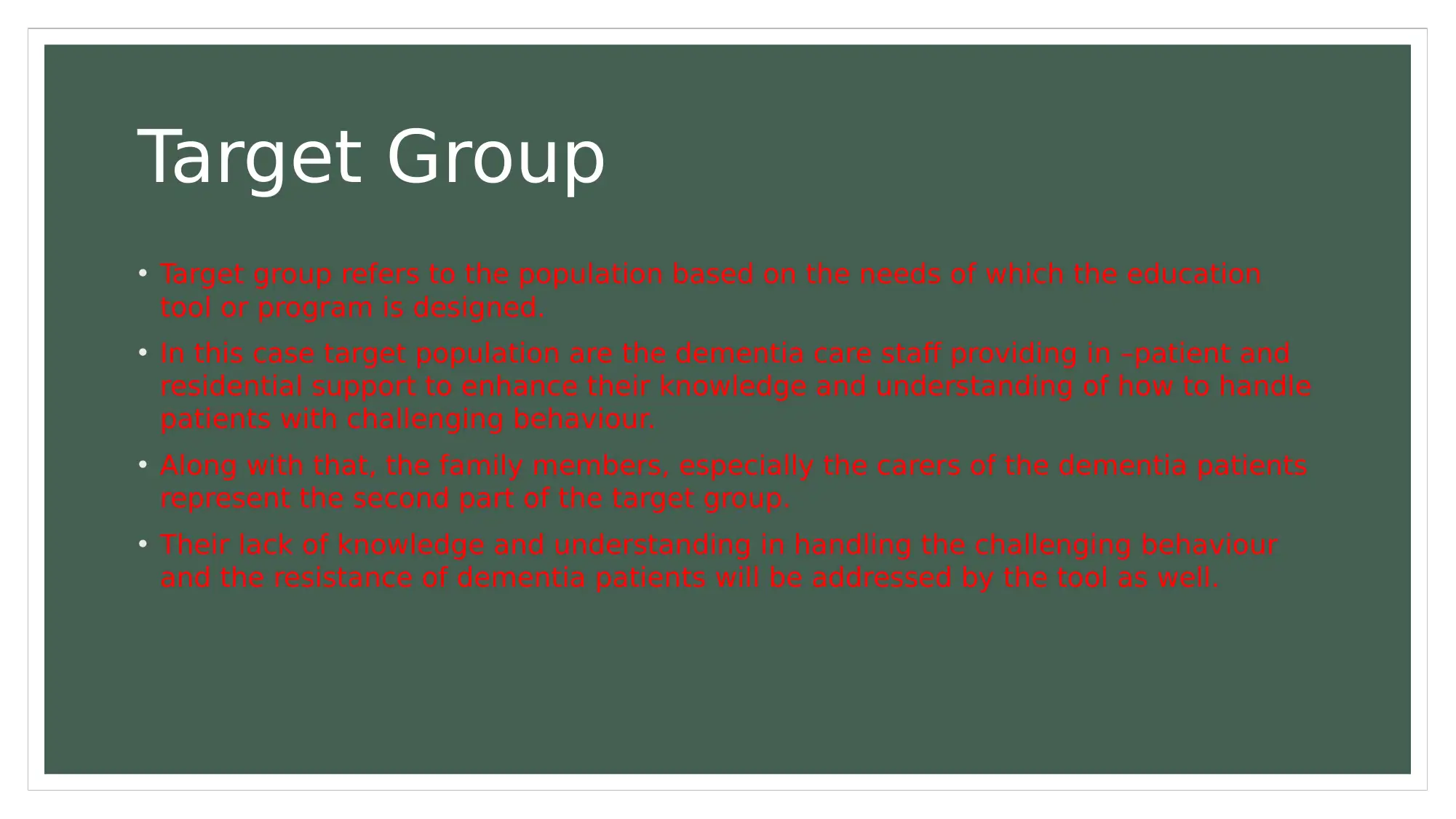
Target Group
• Target group refers to the population based on the needs of which the education
tool or program is designed.
• In this case target population are the dementia care staff providing in –patient and
residential support to enhance their knowledge and understanding of how to handle
patients with challenging behaviour.
• Along with that, the family members, especially the carers of the dementia patients
represent the second part of the target group.
• Their lack of knowledge and understanding in handling the challenging behaviour
and the resistance of dementia patients will be addressed by the tool as well.
• Target group refers to the population based on the needs of which the education
tool or program is designed.
• In this case target population are the dementia care staff providing in –patient and
residential support to enhance their knowledge and understanding of how to handle
patients with challenging behaviour.
• Along with that, the family members, especially the carers of the dementia patients
represent the second part of the target group.
• Their lack of knowledge and understanding in handling the challenging behaviour
and the resistance of dementia patients will be addressed by the tool as well.
Paraphrase This Document
Need a fresh take? Get an instant paraphrase of this document with our AI Paraphraser
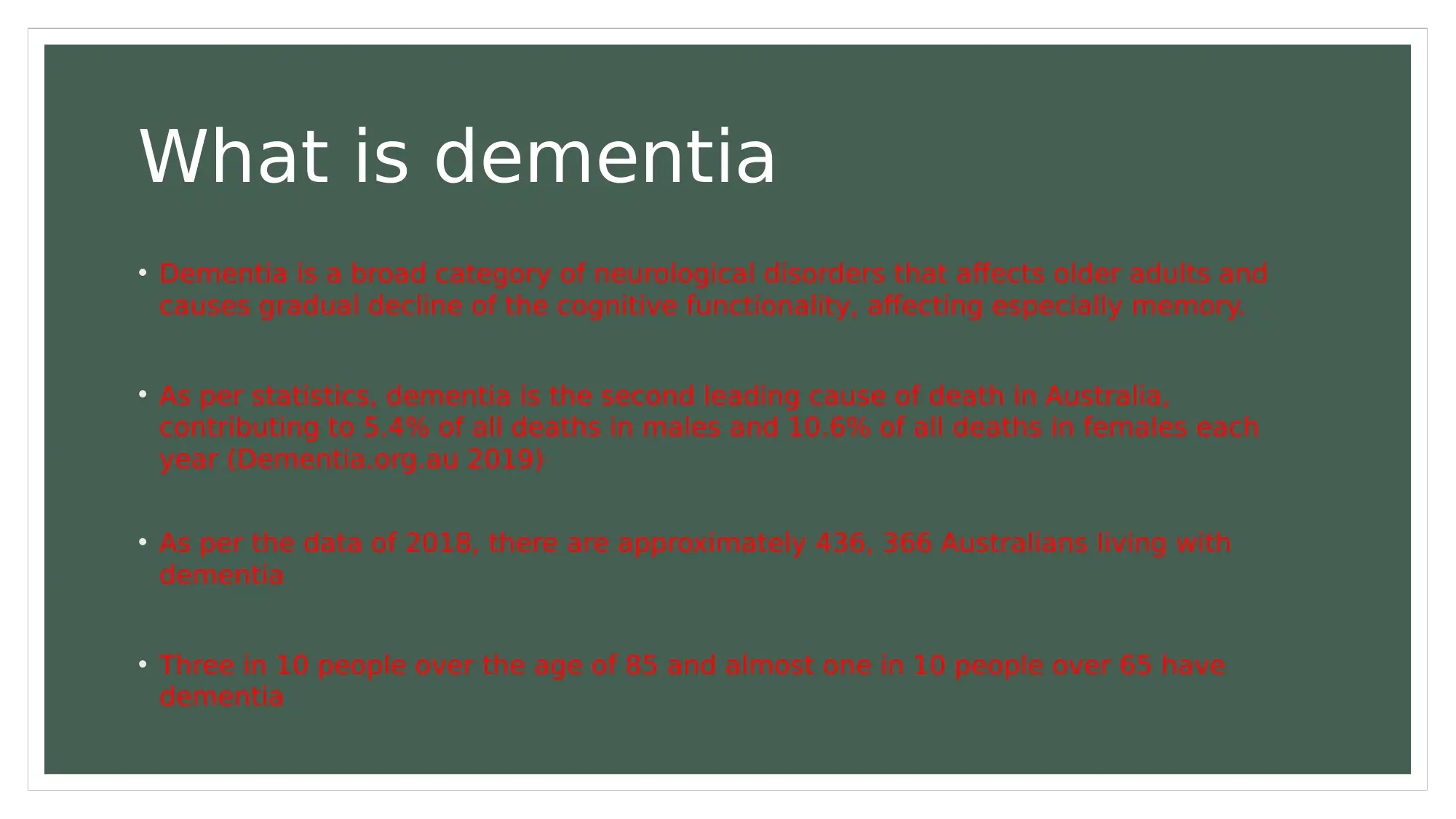
What is dementia
• Dementia is a broad category of neurological disorders that affects older adults and
causes gradual decline of the cognitive functionality, affecting especially memory.
• As per statistics, dementia is the second leading cause of death in Australia,
contributing to 5.4% of all deaths in males and 10.6% of all deaths in females each
year (Dementia.org.au 2019).
• As per the data of 2018, there are approximately 436, 366 Australians living with
dementia
• Three in 10 people over the age of 85 and almost one in 10 people over 65 have
dementia
• Dementia is a broad category of neurological disorders that affects older adults and
causes gradual decline of the cognitive functionality, affecting especially memory.
• As per statistics, dementia is the second leading cause of death in Australia,
contributing to 5.4% of all deaths in males and 10.6% of all deaths in females each
year (Dementia.org.au 2019).
• As per the data of 2018, there are approximately 436, 366 Australians living with
dementia
• Three in 10 people over the age of 85 and almost one in 10 people over 65 have
dementia
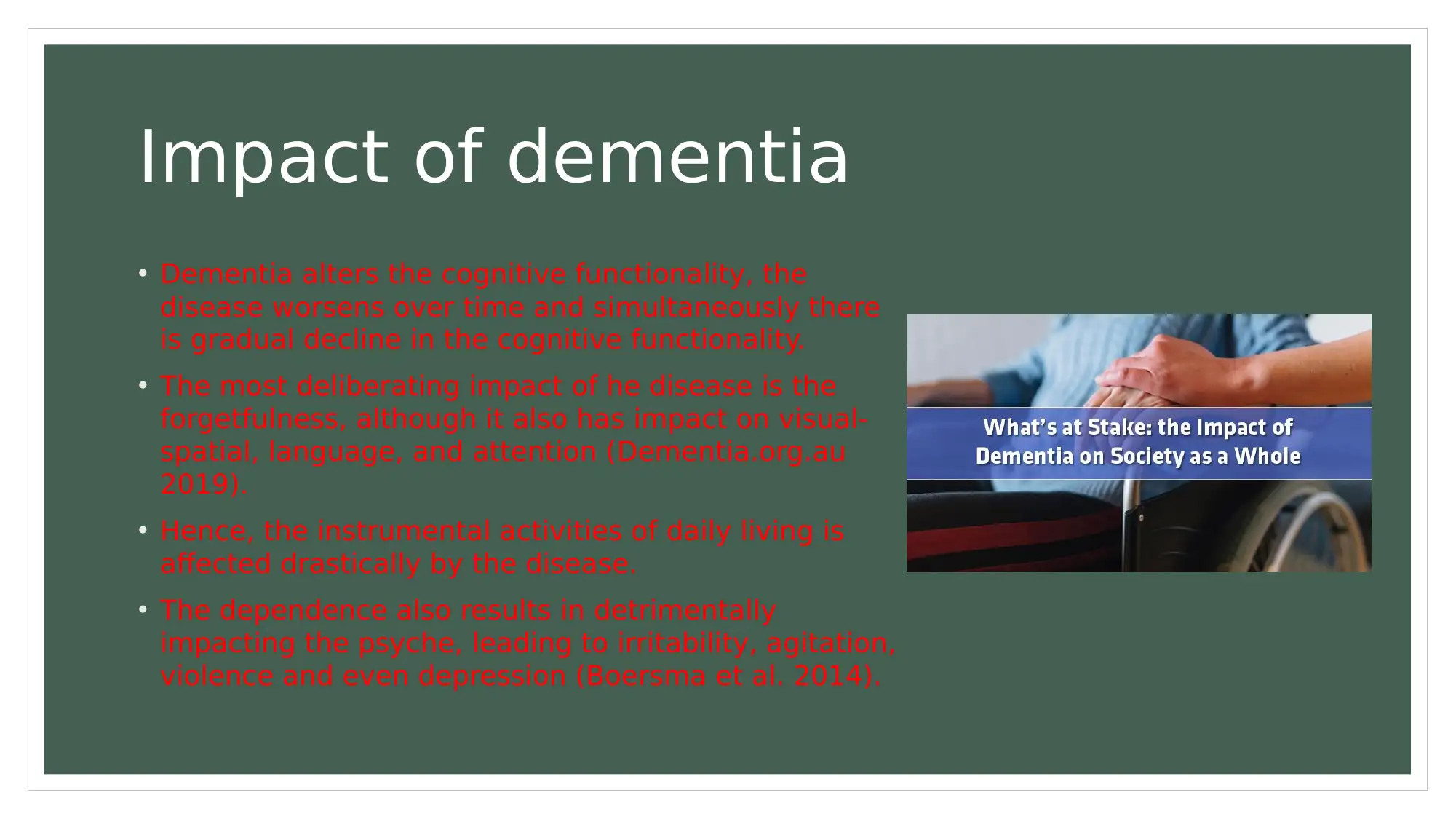
Impact of dementia
• Dementia alters the cognitive functionality, the
disease worsens over time and simultaneously there
is gradual decline in the cognitive functionality.
• The most deliberating impact of he disease is the
forgetfulness, although it also has impact on visual-
spatial, language, and attention (Dementia.org.au
2019).
• Hence, the instrumental activities of daily living is
affected drastically by the disease.
• The dependence also results in detrimentally
impacting the psyche, leading to irritability, agitation,
violence and even depression (Boersma et al. 2014).
• Dementia alters the cognitive functionality, the
disease worsens over time and simultaneously there
is gradual decline in the cognitive functionality.
• The most deliberating impact of he disease is the
forgetfulness, although it also has impact on visual-
spatial, language, and attention (Dementia.org.au
2019).
• Hence, the instrumental activities of daily living is
affected drastically by the disease.
• The dependence also results in detrimentally
impacting the psyche, leading to irritability, agitation,
violence and even depression (Boersma et al. 2014).
⊘ This is a preview!⊘
Do you want full access?
Subscribe today to unlock all pages.

Trusted by 1+ million students worldwide
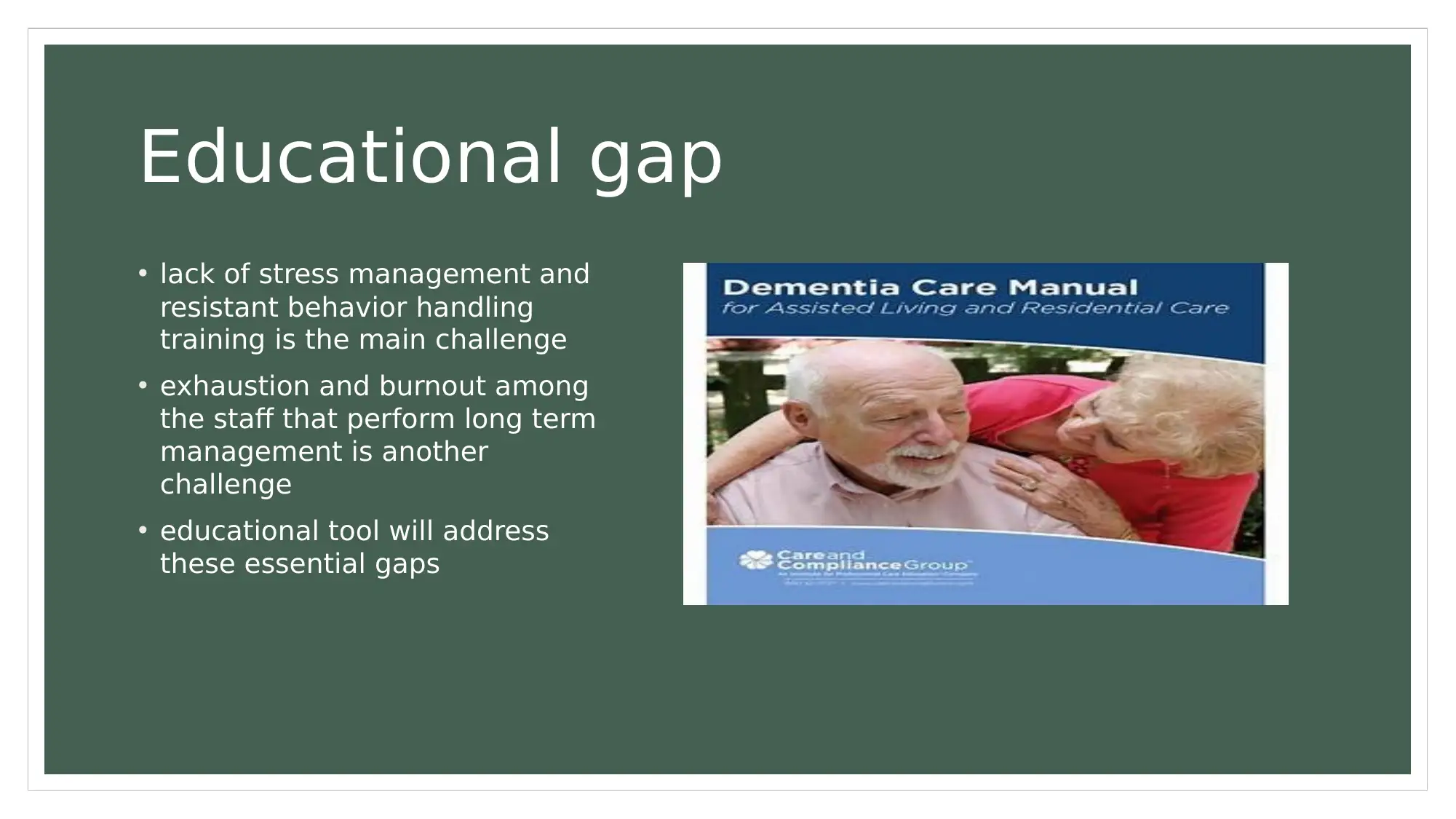
Educational gap
• lack of stress management and
resistant behavior handling
training is the main challenge
• exhaustion and burnout among
the staff that perform long term
management is another
challenge
• educational tool will address
these essential gaps
• lack of stress management and
resistant behavior handling
training is the main challenge
• exhaustion and burnout among
the staff that perform long term
management is another
challenge
• educational tool will address
these essential gaps
Paraphrase This Document
Need a fresh take? Get an instant paraphrase of this document with our AI Paraphraser
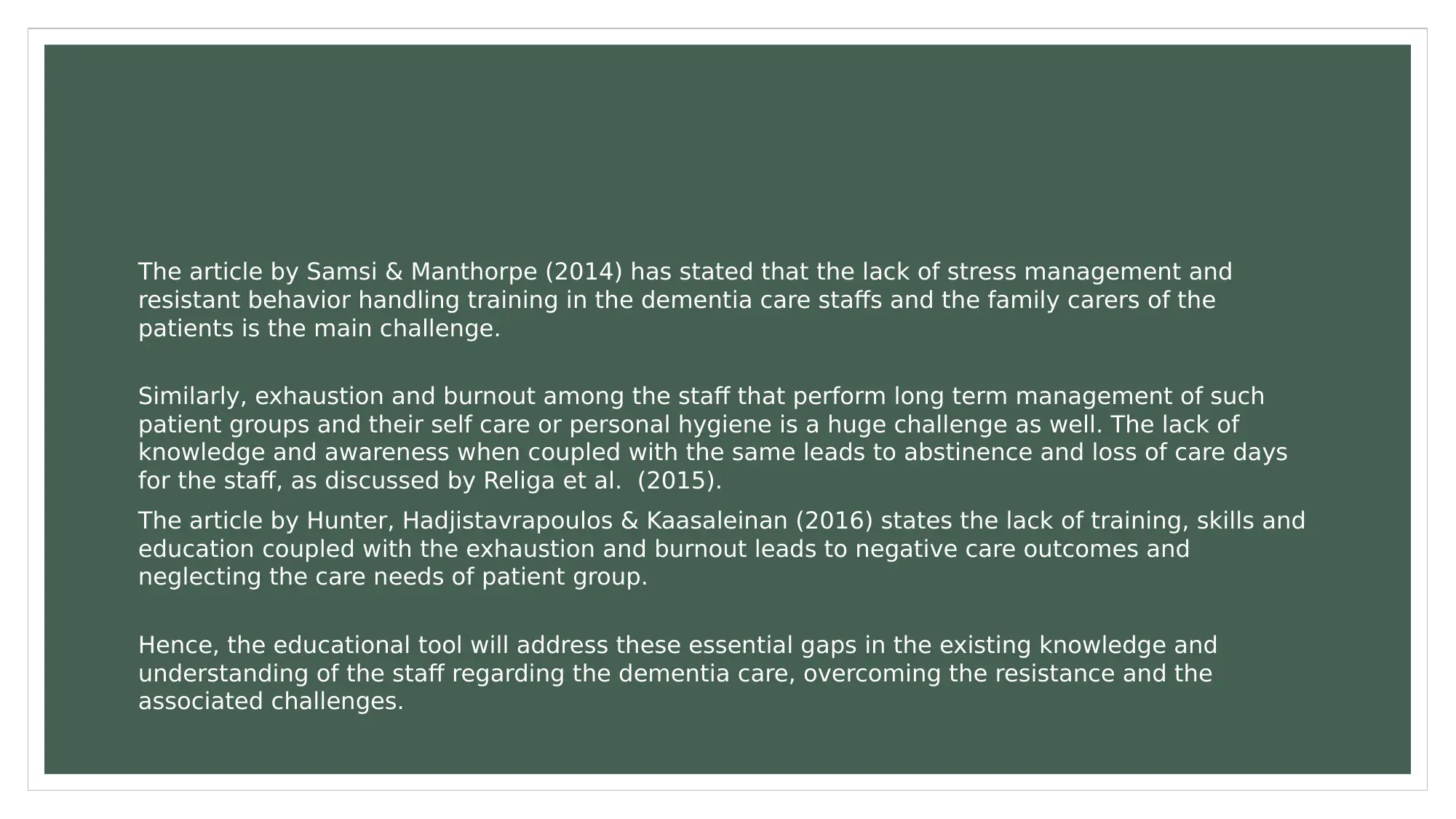
The article by Samsi & Manthorpe (2014) has stated that the lack of stress management and
resistant behavior handling training in the dementia care staffs and the family carers of the
patients is the main challenge.
Similarly, exhaustion and burnout among the staff that perform long term management of such
patient groups and their self care or personal hygiene is a huge challenge as well. The lack of
knowledge and awareness when coupled with the same leads to abstinence and loss of care days
for the staff, as discussed by Religa et al. (2015).
The article by Hunter, Hadjistavrapoulos & Kaasaleinan (2016) states the lack of training, skills and
education coupled with the exhaustion and burnout leads to negative care outcomes and
neglecting the care needs of patient group.
Hence, the educational tool will address these essential gaps in the existing knowledge and
understanding of the staff regarding the dementia care, overcoming the resistance and the
associated challenges.
resistant behavior handling training in the dementia care staffs and the family carers of the
patients is the main challenge.
Similarly, exhaustion and burnout among the staff that perform long term management of such
patient groups and their self care or personal hygiene is a huge challenge as well. The lack of
knowledge and awareness when coupled with the same leads to abstinence and loss of care days
for the staff, as discussed by Religa et al. (2015).
The article by Hunter, Hadjistavrapoulos & Kaasaleinan (2016) states the lack of training, skills and
education coupled with the exhaustion and burnout leads to negative care outcomes and
neglecting the care needs of patient group.
Hence, the educational tool will address these essential gaps in the existing knowledge and
understanding of the staff regarding the dementia care, overcoming the resistance and the
associated challenges.
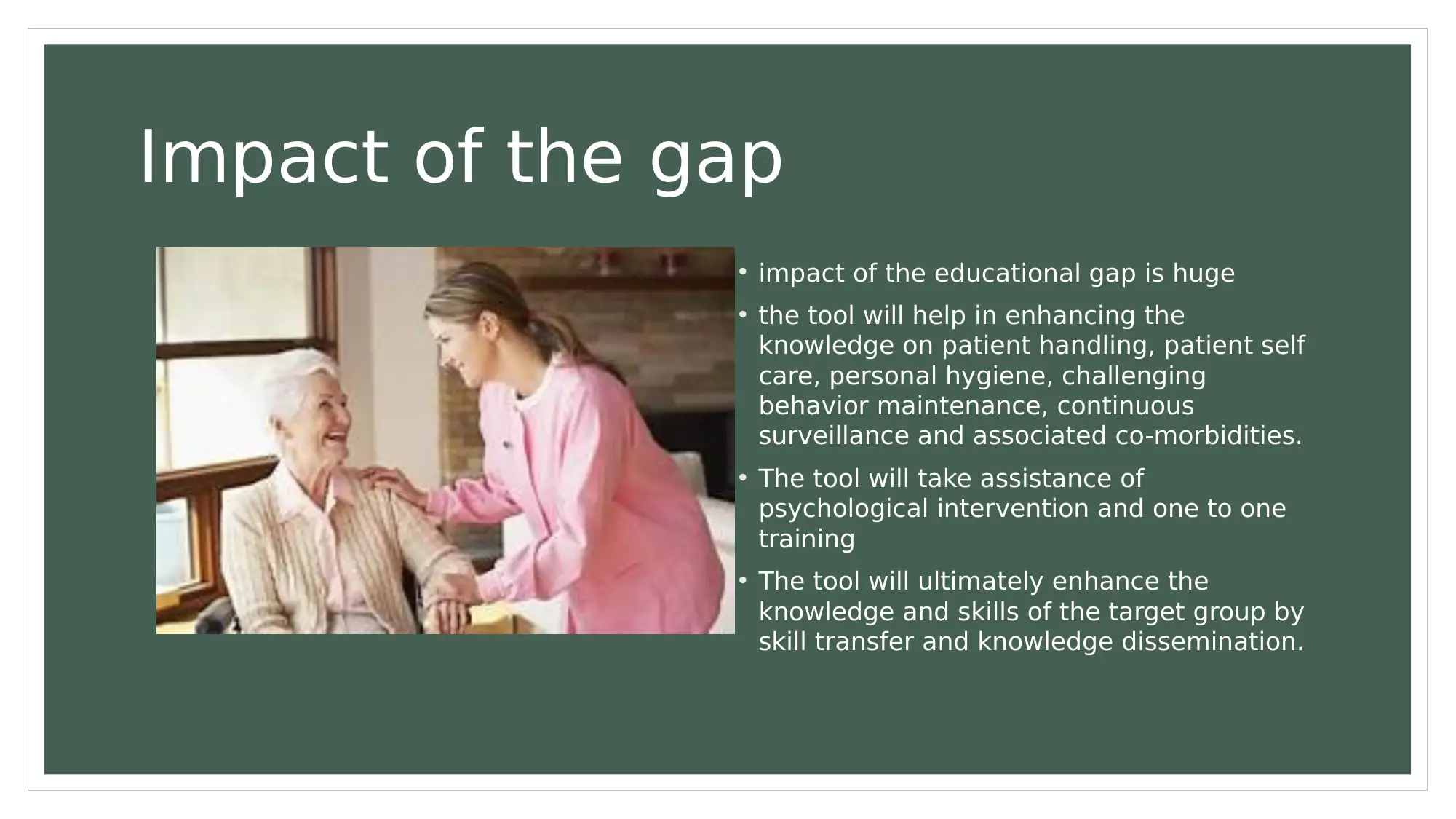
Impact of the gap
• impact of the educational gap is huge
• the tool will help in enhancing the
knowledge on patient handling, patient self
care, personal hygiene, challenging
behavior maintenance, continuous
surveillance and associated co-morbidities.
• The tool will take assistance of
psychological intervention and one to one
training
• The tool will ultimately enhance the
knowledge and skills of the target group by
skill transfer and knowledge dissemination.
• impact of the educational gap is huge
• the tool will help in enhancing the
knowledge on patient handling, patient self
care, personal hygiene, challenging
behavior maintenance, continuous
surveillance and associated co-morbidities.
• The tool will take assistance of
psychological intervention and one to one
training
• The tool will ultimately enhance the
knowledge and skills of the target group by
skill transfer and knowledge dissemination.
⊘ This is a preview!⊘
Do you want full access?
Subscribe today to unlock all pages.

Trusted by 1+ million students worldwide
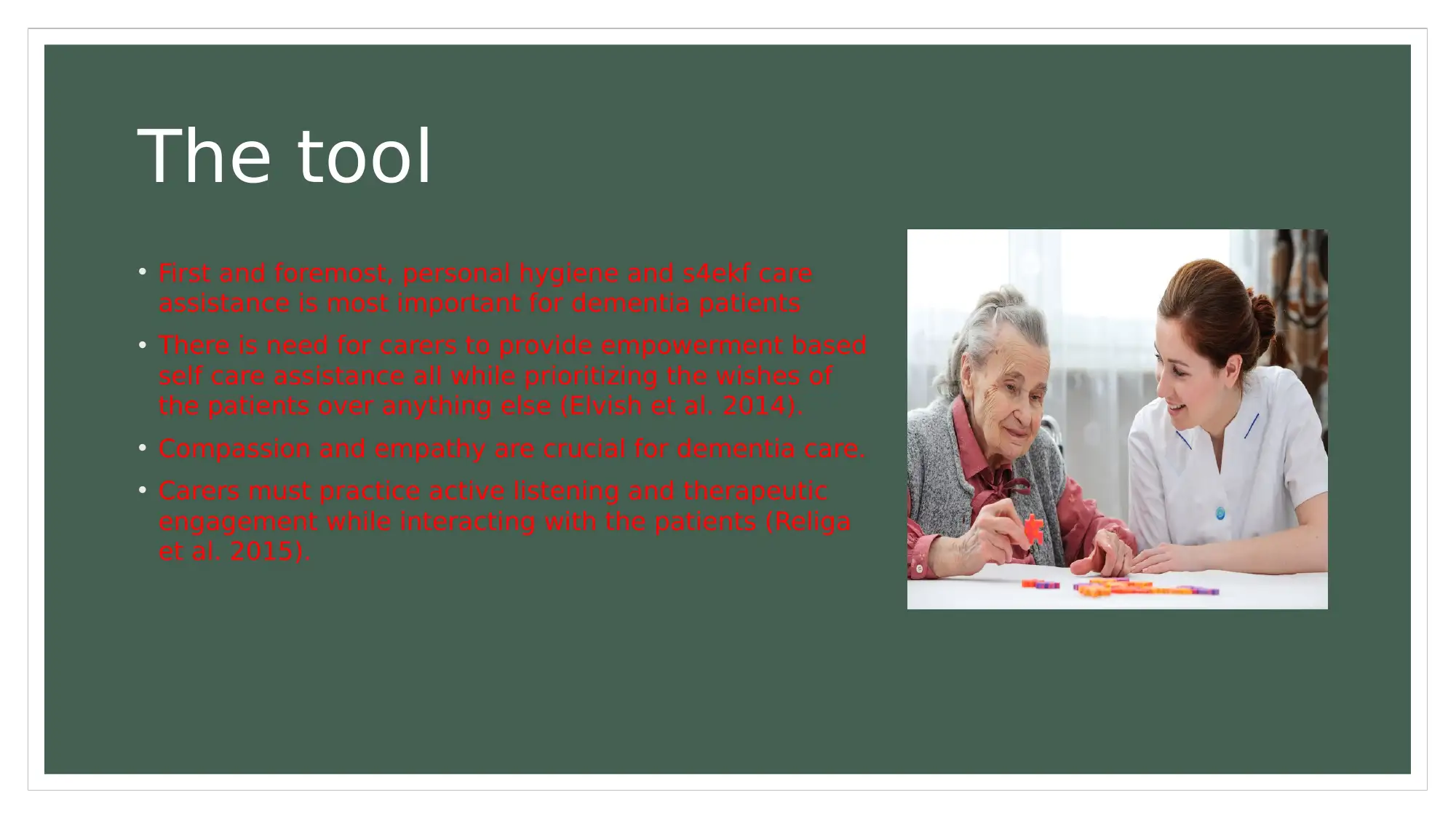
The tool
• First and foremost, personal hygiene and s4ekf care
assistance is most important for dementia patients
• There is need for carers to provide empowerment based
self care assistance all while prioritizing the wishes of
the patients over anything else (Elvish et al. 2014).
• Compassion and empathy are crucial for dementia care.
• Carers must practice active listening and therapeutic
engagement while interacting with the patients (Religa
et al. 2015).
• First and foremost, personal hygiene and s4ekf care
assistance is most important for dementia patients
• There is need for carers to provide empowerment based
self care assistance all while prioritizing the wishes of
the patients over anything else (Elvish et al. 2014).
• Compassion and empathy are crucial for dementia care.
• Carers must practice active listening and therapeutic
engagement while interacting with the patients (Religa
et al. 2015).
Paraphrase This Document
Need a fresh take? Get an instant paraphrase of this document with our AI Paraphraser
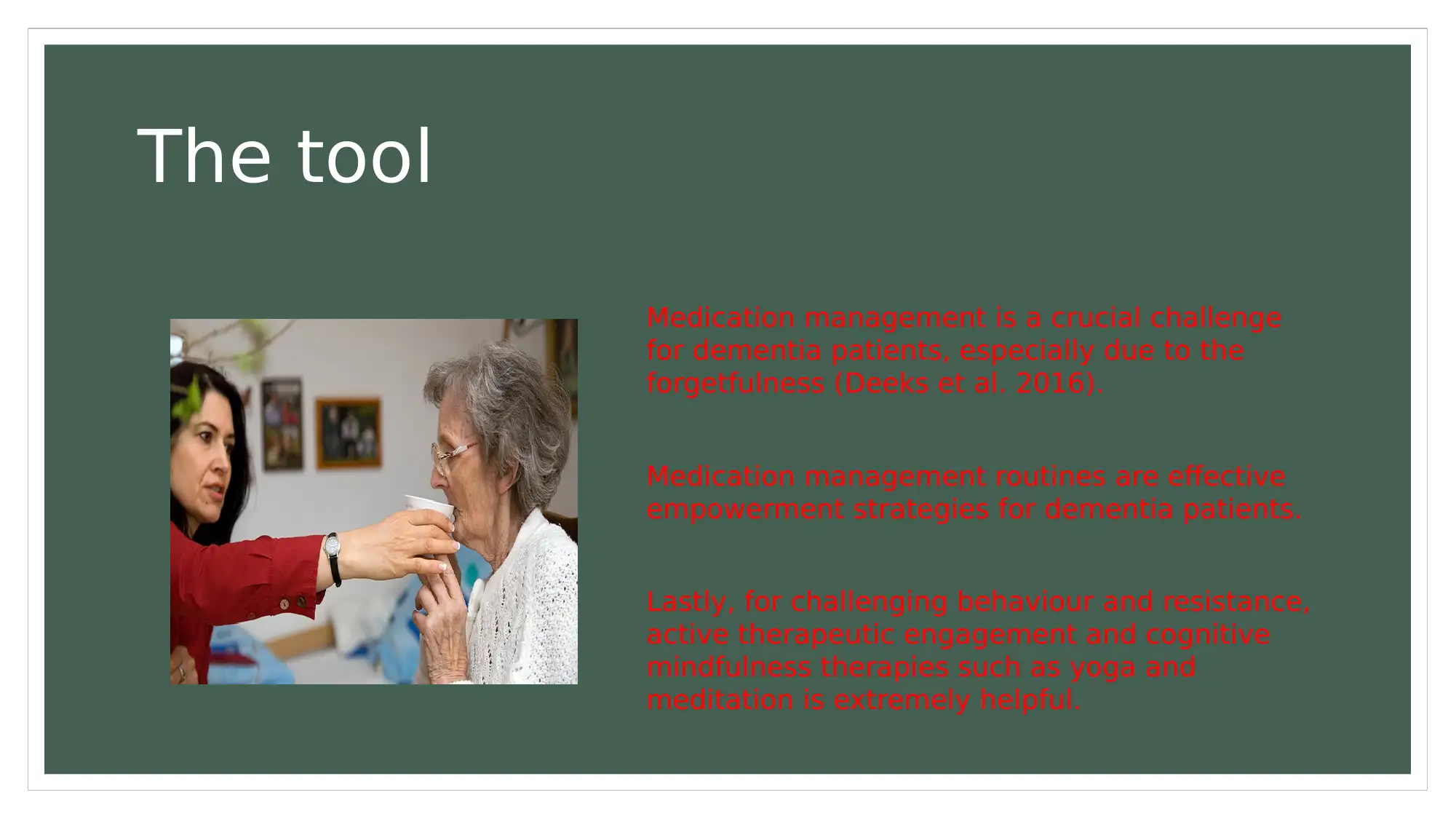
Medication management is a crucial challenge
for dementia patients, especially due to the
forgetfulness (Deeks et al. 2016).
Medication management routines are effective
empowerment strategies for dementia patients.
Lastly, for challenging behaviour and resistance,
active therapeutic engagement and cognitive
mindfulness therapies such as yoga and
meditation is extremely helpful.
The tool
for dementia patients, especially due to the
forgetfulness (Deeks et al. 2016).
Medication management routines are effective
empowerment strategies for dementia patients.
Lastly, for challenging behaviour and resistance,
active therapeutic engagement and cognitive
mindfulness therapies such as yoga and
meditation is extremely helpful.
The tool
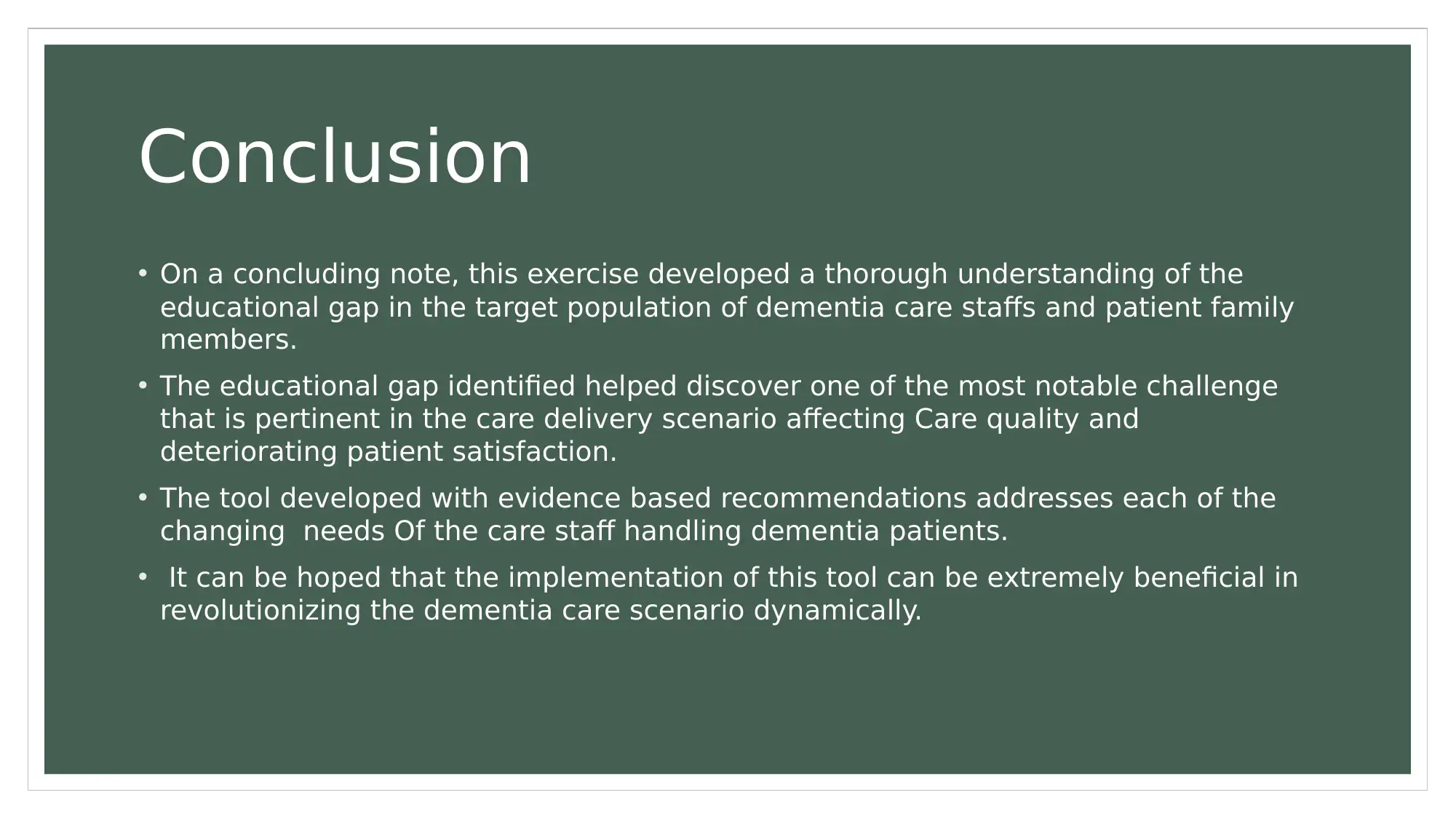
Conclusion
• On a concluding note, this exercise developed a thorough understanding of the
educational gap in the target population of dementia care staffs and patient family
members.
• The educational gap identified helped discover one of the most notable challenge
that is pertinent in the care delivery scenario affecting Care quality and
deteriorating patient satisfaction.
• The tool developed with evidence based recommendations addresses each of the
changing needs Of the care staff handling dementia patients.
• It can be hoped that the implementation of this tool can be extremely beneficial in
revolutionizing the dementia care scenario dynamically.
• On a concluding note, this exercise developed a thorough understanding of the
educational gap in the target population of dementia care staffs and patient family
members.
• The educational gap identified helped discover one of the most notable challenge
that is pertinent in the care delivery scenario affecting Care quality and
deteriorating patient satisfaction.
• The tool developed with evidence based recommendations addresses each of the
changing needs Of the care staff handling dementia patients.
• It can be hoped that the implementation of this tool can be extremely beneficial in
revolutionizing the dementia care scenario dynamically.
⊘ This is a preview!⊘
Do you want full access?
Subscribe today to unlock all pages.

Trusted by 1+ million students worldwide
1 out of 14
Related Documents
Your All-in-One AI-Powered Toolkit for Academic Success.
+13062052269
info@desklib.com
Available 24*7 on WhatsApp / Email
![[object Object]](/_next/static/media/star-bottom.7253800d.svg)
Unlock your academic potential
Copyright © 2020–2025 A2Z Services. All Rights Reserved. Developed and managed by ZUCOL.




